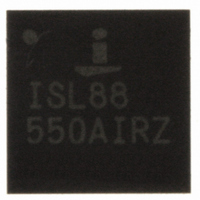ISL88550AIRZ Intersil, ISL88550AIRZ Datasheet - Page 13

ISL88550AIRZ
Manufacturer Part Number
ISL88550AIRZ
Description
IC PWM CONTROLLER 28TQFN
Manufacturer
Intersil
Datasheet
1.ISL88550AIRZ.pdf
(25 pages)
Specifications of ISL88550AIRZ
Applications
PWM Controller
Voltage - Input
2 ~ 25 V
Current - Supply
25µA
Operating Temperature
-40°C ~ 85°C
Mounting Type
Surface Mount
Package / Case
28-TQFN
Rohs Compliant
YES
Lead Free Status / RoHS Status
Lead free / RoHS Compliant
Voltage - Supply
-
Available stocks
Company
Part Number
Manufacturer
Quantity
Price
Company:
Part Number:
ISL88550AIRZ
Manufacturer:
Intersil
Quantity:
480
Part Number:
ISL88550AIRZ
Manufacturer:
INTERSIL
Quantity:
20 000
Company:
Part Number:
ISL88550AIRZ-T
Manufacturer:
AMD
Quantity:
2
Part Number:
ISL88550AIRZ-T
Manufacturer:
INTERSIL
Quantity:
20 000
“Electrical Specifications” table on page 3 are influenced by
resistive losses and by switching delays in the high-side
MOSFET. Resistive losses, which include the inductor, both
MOSFETs, the output capacitors ESR, and any PC board
copper losses in the output and ground, tend to raise the
switching frequency as the load increases. The dead-time
effect increases the effective ON-time, reducing the switching
frequency as one or both dead times are added to the
effective ON-time. The dead time occurs only in PWM mode
(SKIP# = V
when the inductor current reverses at light or negative load
currents. With reversed inductor current, the inductor’s EMF
causes PHASE to go high earlier than normal, extending the
ON-time by a period equal to the UGATE-rising dead time. For
loads above the critical conduction point, where the dead-time
effect is no longer a factor, the actual switching frequency is
shown in Equation 3:
where V
the inductor discharge path, including the synchronous
rectifier, the inductor, and any PC board resistances;
V
including the high-side switch (Q
Circuit" on page 22), the inductor and any PC board
resistances, and
One Shot (t
Automatic Pulse-Skipping Mode (SKIP# = GND)
In skip mode, (SKIP# = GND), an inherent automatic
switchover to PFM takes place at light loads (Figure 22).
This switchover is affected by a comparator that truncates
the low-side switch ON-time at the inductor current’s zero
crossing. The zero-crossing comparator differentially senses
the inductor current across the synchronous rectifier
MOSFET (Q
Once V
threshold (3mV for the default 50mV current-limit threshold),
the comparator forces LGATE low (see “Functional Block
Diagram” on page 11, Figure 21). This mechanism causes
the threshold between pulse-skipping PFM and nonskipping
PWM operation to coincide with the boundary between
continuous and discontinuous inductor-current operation
(also known as the critical conduction point). The load
current level at which PFM/PWM crossover occurs,
I
current, which is a function of the inductor value (see
Figure 22). This threshold is relatively constant, with only a
minor dependence on the input voltage (V
I
f
LOAD(SKIP)
LOAD
SW
DROP2
=
(
SKIP
t
ON
V
PGND
)
OUT
(
DROP1
=
V
is the sum of the resistances in the charging path,
IN
⎛
⎜ ⎜
⎝
DD
V
+
ON
+
, is equal to one-half the peak-to-peak ripple
OUT
V
2
V
2
DROP
) and during dynamic output voltage transitions
- PHASE drops below 5% of the current-limit
DROP
in "Typical Application Circuit" on page 22).
L
)” on page 12).
×
is the sum of the parasitic voltage drops in
K
t
1
ON
2
⎞
⎟ ⎟
⎠
)
⎛
⎜
⎜
⎝
V
is the one-shot on-time (see “ON-Time
IN
−
V
IN
V
OUT
⎞
⎟
⎟
⎠
13
1
in "Typical Application
IN
).
(EQ. 3)
(EQ. 4)
ISL88550A
where K is the ON-time scale factor (see Table 1). For
example, in the “Typical Applications Circuit” on page 22
(K =1.7µs, V
pulse-skipping switchover occurs in Equation 5:
The crossover point occurs at an even lower value if a
swinging (soft-saturation) inductor is used. The switching
waveforms can appear noisy and asynchronous when light
loading causes pulse-skipping operation, but this is a normal
operating condition that results in high light-load efficiency.
Trade-offs in PFM noise vs light-load efficiency are made by
selection of inductor value. Generally, low inductor values
produce a broader efficiency vs load curve, while higher
values result in higher full-load efficiency (assuming that the
coil resistance remains fixed), and less output voltage ripple.
Penalties for using higher inductor values include larger
physical size and degraded load-transient response,
especially at low input voltage levels.
DC output accuracy specifications refer to the threshold of
the error comparator. When the inductor is in continuous
conduction, the ISL88550A regulates the valley of the output
ripple, so the actual DC output voltage is higher than the trip
level by 50% of the output ripple voltage. In discontinuous
conduction (SKIP# = GND and I
output voltage has a DC regulation level higher than the
error comparator threshold by approximately 1.5% due to
slope compensation.
⎛
⎜
⎜
⎝
FIGURE 22. PULSE SKIPPING/DISCONTINUOUS
2
5 .
2
V
×
×
1
µH
1
7 .
µs
0
⎞
⎟
⎟
⎠
⎛
⎜ ⎜
⎝
OUT
Δ I
12
CROSSOVER POINT
t
ON-TIME
V
=
=
12
−
= 2.5V, V
V
V
2
5 .
IN
V
- V
L
⎞
⎟ ⎟
⎠
=
OUT
. 1
68
IN
A
= 12V, and L = 1µH), the
TIME
LOAD
< I
LOAD(SKIP)
I
I
I
LOAD
PEAK
= I
PEAK
April 23, 2008
), the
FN6168.3
(EQ. 5)
/2












